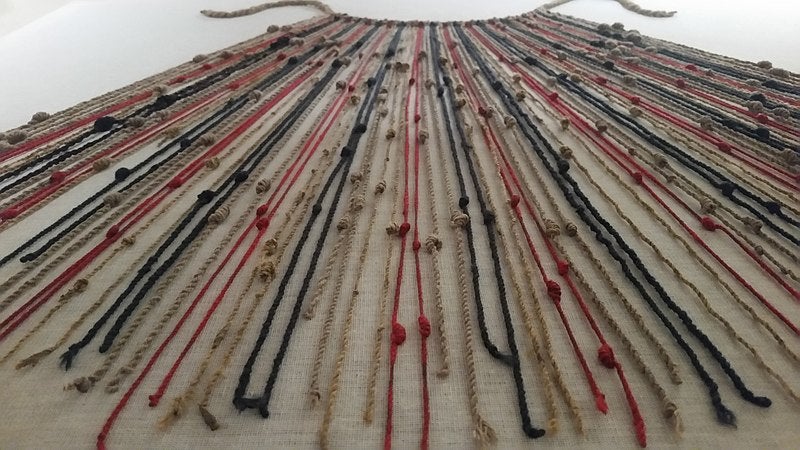Welcome to DU!
The truly grassroots left-of-center political community where regular people, not algorithms, drive the discussions and set the standards.
Join the community:
Create a free account
Support DU (and get rid of ads!):
Become a Star Member
Latest Breaking News
Editorials & Other Articles
General Discussion
The DU Lounge
All Forums
Issue Forums
Culture Forums
Alliance Forums
Region Forums
Support Forums
Help & Search
Anthropology
Related: About this forumInka History in Knots (Book Review)
Gary Urton explains what we can and cannot know about Inka khipus

A khipu from the Museo Machu Picchu, Casa Concha, Cusco. Credit: Pi3.124 Wikimedia (CC BY-SA 4.0)
Imagine that in a few hundred years, archaeologists stumble on some of your old files. Maybe they find spreadsheets of tax information, medical bills, or bank statements, or maybe text files with old emails or drafts of your novel. These archaeologists cannot read Latin script, and no one uses Hindu-Arabic numbers anymore. How do the archaeologists figure out what your files meant? Or can they at all?
The Inka* civilization, which flourished in the fifteenth and sixteenth century and was centered in what is now Peru, used sets of knotted cords called khipus to record information, both quantitative and narrative. Deciphering them has been a challenge, to say the least. I recently read Gary Urton’s book Inka History in Knots: Reading Khipus as Primary Sources, which collects and synthesizes khipu research from his 25 years studying the objects.** It is an invaluable resource for anyone interested in understanding khipus and, more importantly, understanding how and to what extent we can understand them. Scholars have learned to interpret quantitative khipus to a certain degree, but narrative khipus cannot be interpreted at this time.
When I taught math history, I was excited to learn about khipus. When you teach a math history class, it is very easy to end up with a syllabus that covers only Hellenistic and Western European mathematicians and mathematicians. With a little more work, you can incorporate information about ancient Egypt and Mesopotamia and the Islamic world in the Middle Ages. After that, it’s not too hard to throw in some topics related to classical Chinese and Indian mathematics. But engaging with mathematics indigenous to sub-Saharan Africa, Oceania, or the Americas is difficult. Due to colonization by Europeans who believed native people to be intellectually and morally inferior to them and often actively demonized non-European ways of interacting with the world, much knowledge of mathematical thought from those parts of the world has been lost and will probably never be fully reconstructed.
I did not end up teaching khipus in class, in part because of the difficulty I had finding good information about them beyond the very basics that they are knotted cords that can encode a base ten number system. But I did include them as a suggestion for student project topics, and I enjoyed reading student papers about them. Urton’s book would make it easier for a teacher who isn’t a khipu researcher to prepare material for a math history class, but if you are going into the endeavor hoping for a neat and tidy lesson with a satisfying bow on top, you might be disappointed. To me, the most important lesson from the book is about how to approach primary sources from foreign cultures and about the limitations of our understanding of these sources.
More:
https://blogs.scientificamerican.com/roots-of-unity/inka-history-in-knots-book-review/?redirect=1
1 replies
 = new reply since forum marked as read
Highlight:
NoneDon't highlight anything
5 newestHighlight 5 most recent replies
= new reply since forum marked as read
Highlight:
NoneDon't highlight anything
5 newestHighlight 5 most recent replies
Inka History in Knots (Book Review) (Original Post)
Judi Lynn
Jun 2019
OP
These knotted cords may hide the first evidence that the Incas collected taxes
Judi Lynn
Jun 2019
#1
Judi Lynn
(164,038 posts)1. These knotted cords may hide the first evidence that the Incas collected taxes
Stringed devices called khipus are undergoing more research scrutiny, but most remain enigmatic
BY BRUCE BOWER 7:00AM, JUNE 11, 2019

PAY UP A pair of stringed devices called khipus, unearthed at an Inca site in a basket covered with chili peppers, used knots to record taxes on stored quantities of those vegetables, researchers say.
G. URTON
While excavating an Inca outpost on Peru’s southern coast, archaeologist Alejandro Chu and his colleagues uncovered some twisted surprises.
In 2013, the scientists were digging in one of four rooms lining the entrance to what had been a massive storage structure, and they started finding sets of colored and knotted strings poking through the ground. Known as khipus, these odd Inca creations recorded census totals, astronomical events and other matters of state interest. In a society without a writing system, khipus also told stories about Inca rulers’ exploits.
That, at least, is what Spanish chroniclers wrote about khipus in the decades after toppling the Inca empire in 1532. But Spanish accounts, which were based on interviews with royal Inca record keepers, provide only general descriptions of these cord contraptions. Researchers have yet to decipher khipus from various parts of the Inca empire, and it’s a mystery what any particular cord array meant to its makers.

INCA LEVIES Knotted cords created by South America’s Inca empire suggest this mysterious civilization, represented here by ruins of a fortified center in Peru, instituted a tax system shortly before falling to Spanish invaders in 1532.
DEMERZEL21/GETTY IMAGES PLUS
So just finding khipus at the Inkawasi site, an imposing military and administrative site unlike any other known from the Inca world, was a big deal. Inkawasi’s khipus were also unlike any found before, and in a weird way. Most were found covered by the remains of regional crops, mainly peanuts or chili peppers.
More:
https://www.sciencenews.org/article/khipus-knotted-cords-incas-taxes?utm_source=email&utm_medium=email&utm_campaign=latest-newsletter-v2&utm_source=Latest_Headlines&utm_medium=email&utm_campaign=Latest_Headlines